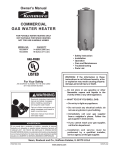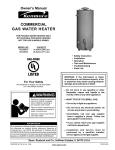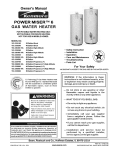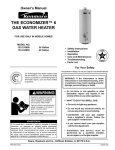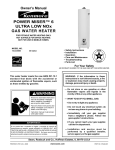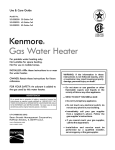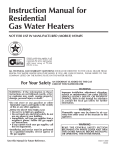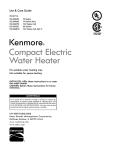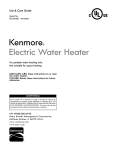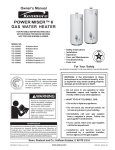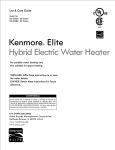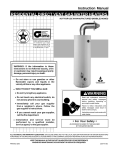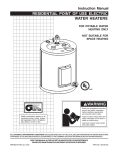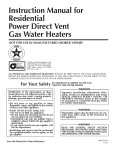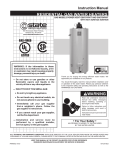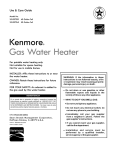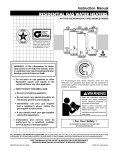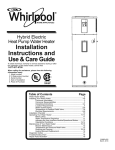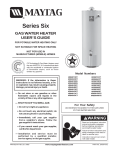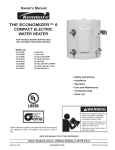Download Kenmore gal.12-Year Installation Guide
Transcript
Use & Care Guide Model No. 153.331762 74 Gallon (280 Liter) Low Lead Content Kenmore Gas Water Heater ® For potable water heating only. Not suitable for space heating. Not for use in mobile homes. INSTALLER: Affix these instructions to or near the water heater. OWNER: Retain these instructions for future reference. FOR YOUR SAFETY: An odorant is added to the gas used by this water heater. ADVERTENCIA Si no puede leer o entender el inglés y necesita el manual de instrucciones en español, puede solicitarlo al 1-800-821-2017. NO TRATE DE INSTALAR U OPERAR ESTE CALENTADOR DE AGUA SI NO ENTIENDE LAS INSTRUCCIONES. No hacer caso de esta advertencia podría originar lesiones graves o mortales. P/N 186079-002 (0512) Sears Brands Management Corporation, Hoffman Estates, IL 60179 U.S.A. www.kenmore.com www.sears.com 1 Safe Installation, Use and Service Your safety and the safety of others is extremely important in the installation, use and servicing of this water heater. Many safety-related messages and instructions have been provided in this manual and on your own water heater to warn you and others of a potential injury hazard. Read and obey all safety messages and instructions throughout this manual. It is very important that the meaning of each safety message is understood by you and others who install, use or service this water heater. This is the safety alert symbol. It is used to alert you to potential personal injury hazards. Obey all safety messages that follow this symbol to avoid possible injury or death. DANGER DANGER indicates an imminently hazardous situation which, if not avoided, will result in injury or death. WARNING WARNING indicates a potentially hazardous situation which, if not avoided, could result in injury or death. CAUTION CAUTION indicates a potentially hazardous situation which, if not avoided, could result in minor or moderate injury. CAUTION CAUTION used without the safety alert symbol indicates a potentially hazardous situation which, if not avoided, could result in property damage. All safety messages will generally tell you about the type of hazard, what can happen if you do not follow the safety message and how to avoid the risk of injury. The California Safe Drinking Water and Toxic Enforcement Act requires the Governor of California to publish a list of substances known to the State of California to cause cancer, birth defects, or other reproductive harm, and requires businesses to warn of potential exposure to such substances. WARNING: This product contains a chemical known to the State of California to cause cancer, birth defects, or other reproductive harm. This appliance can cause low-level exposure to some of the substances included in the act. This product is certified to comply with a maximum weighted average of 0.25% lead content as required in some areas. IMPORTANT DEFINITIONS • Qualified Technician: A qualified technician must have ability equivalent to a licensed tradesman in the fields of plumbing, air supply, venting, and gas supply, including a thorough understanding of the requirements of the National Fuel Gas Code as it relates to the installation of gas fired water heaters. The qualified technician must also be familiar with the design features and use of flammable vapor ignition resistant water heaters, and have a thorough understanding of this instruction manual. • Service Agency: A service agency also must have ability equivalent to a licensed tradesman in the fields of plumbing, air supply, venting and gas supply, including a thorough understanding of the requirements of the National Fuel Gas Code as it relates to the installation of gas fired water heaters. The service agency must also have a thorough understanding of this instruction manual, and be able to perform repairs strictly in accordance with the service guidelines provided by the manufacturer. • Gas Supplier: The natural gas or propane utility or service who supplies gas for utilization by the gas burning appliances within this application. The gas supplier typically has responsibility for the inspection and code approval of gas piping up to and including the natural gas meter or propane storage tank of a building. Many gas suppliers also offer service and inspection of appliances within the building. SAFETY PRECAUTIONS WARNING FIRE AND EXPLOSION HAZARD Can result in serious injury or death FLAMMABLES Do not store or use gasoline or other flammable vapors and liquids in the vicinity of this or any other appliance. Storage of or use of gasoline or other flammable vapors or liquids in the vicinity of this or any other appliance can result in serious injury or death. Flammable Vapors Read and follow water heater warnings and instructions. © Sears Brands Management Corporation 2 SAFETY PRECAUTIONS 3 TABLE OF CONTENTS Safe Installation, Use and Service................................................................................................ 2 SAFETY PRECAUTIONS.............................................................................................................................. 2 SAFETY PRECAUTIONS.............................................................................................................................. 3 TABLE OF CONTENTS................................................................................................................................. 4 PRODUCT warranty............................................................................................................................... 5 CUSTOMER RESPONSIBILITIES................................................................................................................ 6 PRODUCT SPECIFICATIONS...................................................................................................................... 6 MATERIALS AND BASIC TOOLS NEEDED................................................................................................. 7 Materials Needed....................................................................................................................................................... 7 Basic Tools................................................................................................................................................................. 7 TYPICAL INSTALLATION.............................................................................................................................. 8 INSTALLATION requirements............................................................................................................... 9 Removing the Old Water Heater................................................................................................................................. 9 Facts to Consider About the Location........................................................................................................................ 10 Insulation Blankets.................................................................................................................................................... 11 Closed System / Thermal Expansion........................................................................................................................ 12 Combustion Air and Ventilation for Appliances Located in Unconfined Spaces........................................................ 12 Combustion Air and Ventilation for Appliances Located in Confined Spaces............................................................ 12 Water Piping.............................................................................................................................................................. 14 Temperature-Pressure Relief Valve........................................................................................................................... 15 Venting....................................................................................................................................................................... 17 Gas Piping................................................................................................................................................................. 18 Sediment Traps......................................................................................................................................................... 19 Temperature Regulation............................................................................................................................................ 21 SERVICE AND ADJUSTMENT.................................................................................................................... 22 Vent System Inspection............................................................................................................................................. 22 Burner Inspection...................................................................................................................................................... 22 Burner Cleaning......................................................................................................................................................... 22 Housekeeping............................................................................................................................................................ 23 Anode Rod Inspection............................................................................................................................................... 23 Temperature-Pressure Relief Valve Operation.......................................................................................................... 23 Draining..................................................................................................................................................................... 24 Service....................................................................................................................................................................... 24 Start Up Conditions................................................................................................................................................... 25 TROUBLESHOOTING GUIDE..................................................................................................................... 25 Operational Conditions.............................................................................................................................................. 26 Operational Conditions (Continued).......................................................................................................................... 27 TROUBLESHOOTING GUIDE CONTINUED............................................................................................... 28 PARTS ORDER LIST................................................................................................................................... 29 4 PRODUCT warranty 12 - YEAR LIMITED WARRANTY ON WATER HEATER For twelve years from the date of purchase, if this water heater is installed and operated in a single-family home in accordance with the owner’s manual instructions and all local applicable plumbing codes, Sears will: 1. 2. Supply free water heater parts for those that are defective in material or workmanship. Supply a free water heater for one that develops a tank leak. See notes below also. For the second through twelfth year from the purchase date, you must pay the labor cost for installation of parts or water heater. For commercial, institutional, industrial or residential use by two or more families, the above limited warranty is only for two years. During the second year you must pay the labor cost for parts or water heater installation. If governmental regulations prohibit Sears from furnishing a comparable model replacement water heater under this warranty, Sears will furnish a new water heater of comparable output as permitted by such governmental regulations; however, the Owner will be charged for the additional cost associated with the changes made to comply with such governmental regulations. Replacements furnished under this warranty do not carry a new warranty and are only covered by the unexpired portion of the original warranty. 1 - YEAR EXCLUSIVE KENMORE LABOR WARRANTY For the first year from the date of purchase, Sears will, free of charge, supply and install new water heater parts for defective ones or a new water heater for one that develops a leak. WARRANTY SERVICE To obtain warranty service, call 1-800-4-MY-HOME® (1-800-469-4663). This warranty applies only while this product is in use in the United States. This warranty gives you specific legal rights, and you may also have other rights which vary from state to state. SEARS BRANDS MANAGEMENT CORPORATION, Hoffman Estates, IL 60179 The price of your water heater does not include a free checkup service call. On water heater installations arranged by Sears, Sears warrants the installation. A charge will be made on service calls due to poor or incomplete installation. These include: a. Adjusting thermostat b. Condensation c. Leaks in pipes or fittings. Master Protection Agreements Congratulations on making a smart purchase. Your new Kenmore® product is designed and manufactured for years of dependable operation. But like all products, it may require preventive maintenance or repair from time to time. That’s when having a Master Protection Agreement can save you money and aggravation. • $250 Food Loss Protection annually for any food spoilage that is the result of mechanical failure of any covered refrigerator or freezer. • The Master Protection Agreement also helps extend the life of your new product. Here’s what the Agreement* includes: Rental reimbursement if repair of your covered product takes longer than promised. • • Parts and labor needed to help keep products operating properly under normal use, not just defects. Our coverage goes well beyond the product warranty. No deductibles, no functional failure excluded from coverage— real protection. 10% discount off the regular price of any non-covered repair service and related installed parts. Once you purchase the Agreement, a simple phone call is all that it takes for you to schedule service. You can call anytime day or night, or schedule a service appointment online. • Expert service by a force of more than 10,000 authorized Sears service technicians, which means someone you can trust will be working on your product. • Unlimited service calls and nationwide service, as often as you want us, whenever you want us. • “No-lemon” guarantee – replacement of your covered product if four or more product failures occur within twelve months. • Product replacement if your covered product can’t be fixed. • Annual Preventive Maintenance Check at your request – no extra charge. Sears Installation Service • Fast help by phone – we call it Rapid Resolution – phone support from a Sears representative on all products. Think of us as a “talking owner’s manual.” For Sears professional installation of home appliances, garage door openers, water heaters, and other major home items, in the U.S.A. or Canada call 1-800-4-MY-HOME®. • Power surge protection against electrical damage due to power fluctuations. The Master Protection Agreement is a risk free purchase. If you cancel for any reason during the product warranty period, we will provide a full refund. Or, a prorated refund anytime after the product warranty period expires. Purchase your Master Protection Agreement today! Some limitations and exclusions apply. For prices and additional information in the U.S.A. call 1-800-827-6655. * Coverage in Canada varies on some items. For full details, call Sears Canada at 1-800-361-6665. 5 CUSTOMER RESPONSIBILITIES • Carefully plan the place where you are going to put the water heater. Correct combustion, vent action, and vent pipe installation are very important in preventing death from possible carbon monoxide poisoning and fires. See figures 1 and 8 through 14. Thank You for purchasing a Kenmore water heater. Properly installed and maintained, it should give you years of trouble free service. If you should decide that you want the new water heater professionally installed by Sears call 1-800-4-MY-HOME®. They will arrange for prompt, quality installation by Sears authorized contractors. Examine the location to ensure the water heater complies with the Facts to Consider About the Location section in this manual. Abbreviations Found In This Instruction Manual: • • • • • • • UL - Underwriter’s Laboratories CSA - Canadian Standards Association ANSI - American National Standards Institute NFPA - National Fire Protection Association ASME - American Society of Mechanical Engineers EPACT - Energy Policy Act • For California installation this water heater must be braced, anchored, or strapped to avoid falling or moving during an earthquake. See instructions for correct installation procedures. Instructions may be obtained from California’s Office of the State Architect, 1102 Q Street, Suite 5100, Sacramento, CA 95811. Instructions can also be downloaded to your computer at www.dsa.dgs.ca.gov/Pubs. This gas-fired water heater is design certified by UL Underwriter’s Laboratories under American National Standard/ CSA Standard for Gas Water Heaters ANSI Z21.10.3 • CSA 4.3 (current edition). • Massachusetts Code requires this water heater to be installed in accordance with Massachusetts 248-CMR 2.00: State Plumbing Code and 248-CMR 5.00. • Read the “Safety Precautions” section, pages 2 - 3 of this manual first and then the entire manual carefully. If you don’t follow the safety rules, the water heater will not operate properly. It could cause death, serious bodily injury and/or property damage. WARNING Excessive Weight Hazard This manual contains instructions for the installation, operation, and maintenance of the gas-fired water heater. It also contains warnings through out the manual that you must read and be aware of. All warnings and all instructions are essential to the proper operation of the water heater and your safety. Since we cannot put everything on the first few pages, READ THE ENTIRE MANUAL BEFORE ATTEMPTING TO INSTALL OR OPERATE THE WATER HEATER. Use two or more people to move and install the water heater. Failure to do so can result in injury (including back injury). IMPORTANT: Do not remove any permanent instructions, labels, or the data label from either the outside of the water heater or on the inside of water heater panels. • Remove exterior packaging and place installation components aside. • The installation must conform with these instructions and the local code authority having jurisdiction. In the absence of local codes, installations should comply with the current edition of The National Fuel Gas Code ANSI Z223.1/NFPA 54. This publication is available from the Canadian Standards Association, 8501 East Pleasant Valley Rd, Cleveland Ohio 44131, or The National Fire Protection Association, 1 Batterymarch Park, Quincy, MA 02269. • Inspect all parts for damage prior to installation and start-up. • Completely read all instructions before attempting to assemble and install this product. • After installation, dispose of/recycle all packaging materials. • If after reading this manual you have any questions or do not understand any portion of the instructions, call the Sears Service Center. PRODUCT SPECIFICATIONS RECOVERYMINIMUM DIMENSIONS TANK TYPE RATE GALS.VENT PIPE DIAMETER IN INCHES (mm) MODEL CAPACITY OF BTU PER HOUR INCHES INCHES HEIGHT TO NUMBER IN GALS (LTRS) GAS RATE @ 90°F RISE (mm) (mm) JACKET TOP 153.331762 74 (280) NATURAL 75,100 80.9 6 4” (102) 26.38” (670) 57” (1,448) MATERIALS AND BASIC TOOLS NEEDED Materials Needed To simplify the installation Sears has available the installation parts shown below. You may or may not need all of these materials, depending on your type of installation. METAL DRAIN PANS AVAILABLE IN 20” (508 mm) DIAMETER FOR WATER HEATERS HAVING A DIAMETER 18” (457 mm) OR LESS, 24” (610mm) DIAMETER F O R WAT E R H E AT E R S H AV I N G A DIAMETER 22” (559 mm) OR LESS AND AVAILABLE IN 28” (711 mm) DIAMETER F O R WAT E R H E AT E R S H AV I N G A DIAMETER 26” (660 mm) OR LESS EXPANSION TANKS FOR THERMAL EXPANSION CONDITIONS AVAILABLE IN 2 GALLONS (7.6 LITERS) AND 5 GALLONS (18.9 LITERS) CAPACITY THROUGH LOCAL SEARS STORE OR SERVICE CENTER Basic Tools Additional Tools Needed When Sweat Soldering You may or may not need all these tools, depending on your type of installation. These tools can be purchased at your local Sears Store. • • • • • • • Pipe Wrenches (2) 14” (356 mm) Screwdriver Tin Snips 6’ (1.82 m) Tape or Folding Ruler Garden Hose Drill Pipe Dope or Teflon Tape • • • • • • DRILL TUBING CUTTER SLOT-HEAD SCREWDRIVER PROPANE TORCH TIN SNIPS PHILLIPS SCREWDRIVER ROLL OF TEFLON TAPE (USE ONLY ON WATER HEATER CONNECTIONS) Tubing Cutters or Hacksaw Propane Torch Soft Solder Solder Flux Emery Cloth Wire Brushes HACKSAW PIPE DOPE (SQUEEZE TUBE) USE FOR WATER AND GAS CONNECTIONS ROLL OF EMERY CLOTH 3/4” (19 mm) WIRE BRUSH GARDEN HOSE 6 FOOT TAPE PIPE WRENCH 1/2” (13 mm) WIRE BRUSH 7 ROLL OF LEAD-FREE SOFT SOLDER SOLDER FLUX TYPICAL INSTALLATION GET TO KNOW YOUR WATER HEATER - GAS MODELS A Vent Pipe B Draft Hood CAnode D Tempered Hot Water Outlet EOutlet FWater Connections G Gas Supply H Manual Gas Shut-off Valve I J K L M N O P Q Ground Joint Union R Sediment Trap S Inner Door T Outer door Untempered Hot Water Outlet (optional) U V Inlet Water Shut-off Valve W Cold Water Inlet X Inlet Dip Tube Temperature-Pressure Relief Valve Rating Plate Flue Baffle(s) Gas Control Valve Thermostat Drain Valve Pilot and Main Burner Flue Metal Drain Pan *INSTALL IN ACCORDANCE WITH LOCAL CODES. * S E D I M E N T T R A P A S REQUIRED BY LOCAL CODES. To vent termination on roof PREFERRED METHOD (T) THERMOSTAT (V) PILOT & MAIN BURNER *ALL PIPING MATERIALS TO BE SUPPLIED BY CUSTOMERS. **CLOSED WATER SYSTEMS ARE THOSE WITH BACK FLOW PREVENTION DEVICES INSTALLED IN THE INLET WATER SERVICE LINE. FIGURE 1. 8 INSTALLATION requirements Removing the Old Water Heater 4. Attach a hose to the water heater drain valve and put the other end in a floor drain or outdoors. Open the water heater drain valve. Open a nearby hot water faucet which will relieve pressure in the water heater and speed draining. The water passing out of the drain valve may be extremely hot. To avoid being scalded, make sure all connections are tight and that the water flow is directed away from any person, see Figures 2 and 5. FIGURE 5. 5. Disconnect the vent pipe from the draft hood where it connects to the water heater. In most installations the vent pipe can be lifted off after any screw or other attached devices are removed. Dispose of the draft hood. The new water heater has a draft hood which must be used for proper operation. 6. If you have copper piping to the water heater, the two copper water pipes can be cut with a hacksaw approximately four inches away from where they connect to the water heater, see Figure 6. This will avoid cutting off pipes too short. Additional cuts can be made later if necessary. Disconnect the temperature-pressure relief valve drain line. When the water heater is drained, disconnect the hose from the drain valve. Close the drain valve. The water heater is now completely disconnected and ready to be removed. FIGURE 2. 1. Turn “OFF” the gas supply to the water heater. If the main gas line Shut-off valve serving all gas appliances is used, also shut “OFF” the gas at each appliance. Leave all gas appliances shut “OFF” until the water heater installation is completed, see Figures 2 and 3. 2. Turn “OFF” the water supply to the water heater at the water shut off valve or water meter. Some installations require that the water be turned off to the entire house, see Figures 2 and 4. FIGURE 3. FIGURE 4. 3. Check again to make sure the gas supply is “OFF” to the water heater. Then disconnect the gas supply connection from the gas control valve. FIGURE 6. If you have galvanized pipes to the water heater, loosen the two galvanized pipes with a pipe wrench at the union in each line. Also disconnect the piping remaining to the water heater, see Figure 7. These pieces should be saved since they may be needed when reconnecting the new water heater. Disconnect the temperature-pressure relief valve drain line. When the water heater is drained, disconnect the hose from the drain valve. Close the drain valve. The water heater is now completely disconnected and ready to be removed. Mineral buildup or sediment may have accumulated in the old water heater. This causes the water heater to be much heavier than normal and this residue, if spilled out, could cause staining. FIGURE 7. 9 Facts to Consider About the Location Carefully choose an indoor location for the new water heater, because the placement is a very important consideration for the safety of the occupants in the building and for the most economical use of the water heater. This water heater is not for use in manufactured (mobile) homes or outdoor installation. Whether replacing an old water heater or putting the water heater in a new location, the following critical points must be observed: • Select a location indoors as close as practical to the gas vent or chimney to which the water heater vent is going to be connected, and as centralized with the water piping system as possible. • Selected location must provide adequate clearances for servicing and proper operation of the water heater. INSTALLATIONS IN AREAS WHERE FLAMMABLE LIQUIDS (VAPORS) ARE LIKELY TO BE PRESENT OR STORED (GARAGES, STORAGE AND UTILITY AREAS, ETC.): Flammable liquids (such as gasoline, solvents, propane [LP or butane, etc.] and other substances such as adhesives, etc.) emit flammable vapors which can be ignited by a gas water heater’s pilot light or main burner. The resulting flashback and fire can cause death or serious burns to anyone in the area, as well as property damage. If installation in such areas is your only option, then the installation must be accomplished in a way that the pilot flame and main burner flame are elevated from the floor at least 18 inches. While this may reduce the chances of flammable vapors, from a floor spill being ignited, gasoline and other flammable substances should never be stored or used in the same room or area containing a gas water heater or other open flame or spark producing appliance. NOTE: Flammable vapors may be drawn by air currents from other areas of the structure to the appliance. Installation of the water heater must be accomplished in such a manner that if the tank or any connections should leak, the flow will not cause damage to the structure. For this reason, it is not advisable to install the water heater in an attic or upper floor. When such locations cannot be avoided, a suitable metal drain pan should be installed under the water heater. Metal drain pans are available at your local Sears or hardware store. Such a metal drain pan must have a minimum length and width of at least 2 inches (51 mm) greater that the water heater dimensions and must be piped to an adequate drain. The pan must not restrict combustion air flow. Water heater life depends upon water quality, water pressure and the environment in which the water heater is installed. Water heaters are sometimes installed in locations where leakage may result in property damage, even with the use of a metal drain pan piped to a drain. However, unanticipated damage can be reduced or prevented by a leak detector or water shut-off device used in conjunction with a piped metal drain pan. These devices are available from some plumbing supply wholesalers and retailers, and detect and react to leakage in various ways: • Sensors mounted in the metal drain pan that trigger an alarm or turn off the incoming water to the water heater when leakage is detected. Also, the water heater must be located and/or protected so it is not subject to physical damage by a moving vehicle. • Sensors mounted in the metal drain pan that turn off the water supply to the entire home when water is detected in the metal drain pan. • Water supply shut-off devices that activate based on the water pressure differential between the cold water and hot water pipes connected to the water heater. • Devices that will turn off the gas supply to a gas water heater while at the same time shutting off its water supply. 10 This water heater must not be installed directly on carpeting. Carpeting must be protected by metal or wood panel beneath the appliance extending beyond the full width and depth of the water heater by at least 3 inches (76.2 mm) in any direction, or if the appliance is installed in an alcove or closet, the entire floor must be covered by the panel. Failure to heed this warning may result in a fire hazard. FIGURE 9. If this water heater will be used in beauty shops, barber shops, cleaning establishments, or self-service laundries with dry cleaning equipment, it is imperative that the water heater or water heaters be installed so that combustion and ventilation air be taken from outside these areas. Propellants of aerosol sprays and volatile compounds, (cleaners, chlorine based chemicals, refrigerants, etc.) in addition to being highly flammable in many cases, will also change to corrosive hydrochloric acid when exposed to the combustion products of the water heater. The results can be hazardous, and also cause product failure. Minimum clearances between the water heater and combustible construction are 0 inch at the sides and rear, 4 inches (102 mm) at the front, and 6 inches (153 mm) from the vent pipe, see Figure 8. Clearance from the top of the jacket is 12 inches (305 mm) on most models. Note that a lesser dimension may be allowed on some models, refer to the label attached adjacent to the gas control valve on the water heater. Insulation Blankets Insulation blankets available to the general public for external use on gas water heaters are not necessary with Kenmore products. The purpose of an insulation blanket is to reduce the standby heat loss encountered with storage tank heaters. Your Kenmore water heater meets or exceeds the EPACT standards with respect to insulation and standby loss requirements, making an insulation blanket unnecessary. FIGURE 8. WARNING Should you choose to apply an insulation blanket to this heater, you should follow these instructions (See Figure 1 for identification of components mentioned below). Failure to follow these instructions can restrict the air flow required for proper combustion, potentially resulting in fire, asphyxiation, serious personal injury or death. A gas water heater cannot operate properly without the correct amount of air for combustion, see Figure 9. Do not install in a confined area such as a closet, unless you provide air as shown in the Combustion Air and Ventilation for Appliances Located in Confined Spaces section. Never obstruct the flow of ventilation air. If you have any doubts or questions at all, call your gas supplier. Failure to provide the proper amount of combustion air can result in a fire or explosion and cause death, serious bodily injury, or property damage. • Do not apply insulation to the top of the water heater, as this will interfere with safe operation of the draft hood. • Do not cover the outer door, thermostat or temperature & pressure relief valve. • Do not allow insulation to come within 2” (50.8 mm) of the floor to prevent blockage of combustion air flow to the burner. 11 combined space should be considered in making this determination. Each opening should have a minimum free area of one square inch per 1,000 Btu per hour (22 cm 2/ kW) of the total input rating of all gas utilization equipment in the confined space, but not less than 100 square inches (645 cm2). One opening should commence within 12 inches (30 cm) of the top and one commencing within 12 inches (30 cm) of the bottom of the enclosures. • Do not cover the instruction manual. Keep it on the side of the water heater or nearby for future reference. • Do obtain new warning and instruction labels from Sears for placement on the blanket directly over the existing labels. • Do inspect the insulation blanket frequently to make certain it does not sag, thereby obstructing combustion air flow. Closed System / Thermal Expansion As water is heated, it expands (thermal expansion). In a closed system, the volume of water will grow. As the volume of water grows, there will be a corresponding increase in water pressure due to thermal expansion. Thermal expansion can cause premature tank failure (leakage). This type of failure is not covered under the limited warranty. Thermal expansion can also cause intermittent temperature-pressure relief valve operation: water discharged from the valve due to excessive pressure build up. The temperaturepressure relief valve is not intended for the constant relief of thermal expansion. This condition is not covered under the limited warranty. A properly sized thermal expansion tank should be installed on all closed systems to control the harmful effects of thermal expansion. Thermal expansion tanks are available from Sears stores and through the Sears Service Centers. Contact the local plumbing inspector, water supplier and/or the Sears Service Center for assistance in controlling these situations. (For additional information, see the Troubleshooting Guide later thermal expansion. FIGURE 10. B. ALL AIR FROM OUTDOORS: (See Figures 9, 11,12 and 13) The confined space should be provided with two permanent openings, one commencing within 12 inches (30 cm) of the top and one commencing within 12 inches (30 cm) from the bottom of the enclosure. The openings should communicate directly, or by ducts, with the outdoors or spaces (crawl or attic) that freely communicate with the outdoors. Combustion Air and Ventilation for Appliances Located in Unconfined Spaces Unconfined Space is space whose volume is not less than 50 cubic feet per 1,000 Btu per hour (4.8 m3 per kW) of the aggregate input rating of all appliances installed in that space. Rooms communicating directly with the space in which the appliances are installed, through openings not furnished with doors, are considered a part of the unconfined space. In unconfined spaces in buildings, infiltration may be adequate to provide air for combustion, ventilation and dilution of flue gases. However, in buildings of tight construction (for example, weather stripping, heavily insulated, caulked, vapor barrier, etc.), additional air may need to be provided using the methods described in Combustion Air and Ventilation for Appliances Located in Confined Spaces. Combustion Air and Ventilation for Appliances Located in Confined Spaces Confined Space is a space whose volume is less than 50 cubic feet per 1,000 Btu per hour (4.8 m3 per kW) of the aggregate input rating of all appliances installed in that space. FIGURE 11. A. ALL AIR FROM INSIDE BUILDINGS: (See Figure 9 and Figure 10) • When directly communicating with the outdoors, each opening should have a minimum free area of 1 square inch per 4,000 Btu per hour (5.5 cm2/kW) of total input rating of all equipment in the enclosure, see Figure 12. The confined space should be provided with two permanent openings communicating directly with an additional room(s) of sufficient volume so that the combined volume of all spaces meets the criteria for an unconfined space. The total input of all gas utilization equipment installed in the 12 FIGURE 12. • When communicating with the outdoors through vertical ducts, each opening should have a minimum free area of 1 square inch per 4,000 BTU per hour (5.5 cm2/kW) of total input rating of all equipment in the enclosure, see Figure 12 on page 11. FIGURE 14. • Louvers and Grilles: In calculating free area, consideration should be given to the blocking effect of louvers, grilles or screens protecting openings. Screens used should not be smaller than 1/4 inch (6.4 mm) mesh. If the free area through a design of louver or grille is known, it should be used in calculating the size opening required to provide the free area specified. If the design and free area is not known, it may be assumed that wood louvers will be 20-25 percent free area and metal louvers and grilles will have 60-75 percent free area. Louvers and grilles should be fixed in the open position or interlocked with the equipment so that they are opened automatically during equipment operation. • When communicating with the outdoors through horizontal ducts, each opening should have a minimum free area of 1 square inch per 2,000 BTU per hour (11 cm2/kW) of total input rating of all equipment in the enclosure, see Figure 14. • Alternatively a single permanent opening may be used when communicating directly with the outdoors, or with spaces that freely communicate with the outdoors. The opening should have a minimum free area of 1 square inch per 3,000 BTU per hour (8.3 cm2/kW) of total input rating of all equipment in enclosure. See Figure 13. • Special Conditions Created by Mechanical Exhausting or Fireplaces: operation of exhaust fans, ventilation systems, clothes dryers or fireplaces may create conditions requiring special attention to avoid unsatisfactory operation of installed gas utilization equipment. FIGURE 13 • When ducts are used, they should be of the same crosssectional area as the free area of the openings to which they connect. The minimum short side dimension of rectangular air ducts should not be less than 3 inches (76.2 mm), see Figure 14. 13 Water Piping reducing valves, check valves, back flow preventers, etc. to control these types of problems. When these devices are not equipped with an internal by-pass, and no other measures are taken, the devices cause the water system to be closed. As water is heated, it expands (thermal expansion) and closed systems do not allow for the expansion of heated water. The water within the water heater tank expands as it is heated and increases the pressure of the water system. If the relieving point of the water heater’s temperature-pressure relief valve is reached, the valve will relieve the excess pressure. The temperature-pressure relief valve is not intended for the constant relief of thermal expansion. This is an unacceptable condition and must be corrected. It is recommended that any devices installed which could create a closed system have a by-pass and/or the system have an expansion tank to relieve the pressure built by thermal expansion in the water system. Refer to the Thermal Expansion section under Troubleshooting Guide or contact local plumbing authority or local Sears Service Center on how to control this situation. HOTTER WATER CAN SCALD: Water heaters are intended to produce hot water. Water heated to a temperature which will satisfy space heating, clothes washing, dish washing, cleaning and other sanitizing needs can scald and permanently injure you upon contact. Some people are more likely to be permanently injured by hot water than others. These include the elderly, children, the infirm, or physically/mentally handicapped. If anyone using hot water in your home fits into one of these groups or if there is a local code or state law requiring a certain temperature water at the hot water tap, then you must take special precautions. In addition to using the lowest possible temperature setting that satisfies your hot water needs, a means such as a mixing valve should be used at the hot water taps used by these people or at the water heater. Mixing valves are available at plumbing supply or hardware stores, see Figure 15 below. Valves for reducing point of use temperature by mixing cold and hot water are also available. Follow manufacturer’s instructions for installation of the valves. Before changing the factory setting on the thermostat, read the Temperature Regulation section in this manual. NOTE: To protect against untimely corrosion of hot and cold water fittings, it is strongly recommended that di-electric unions or couplings be installed on this water heater when connected to copper pipe. Figure 16 shows the typical attachment of the water piping to the water heater. The 74-gallon model water heater is equipped with 1” NPT water connections. FIGURE 15. Water supply systems may, because of such events as high line pressure, frequent cut-offs or the effects of water hammer among others, have installed devices such as pressure 14 Temperature-Pressure Relief Valve TYPICAL INSTALLATION This heater is provided with a properly certified combination temperature - pressure relief valve by the manufacturer. The valve is certified by a nationally recognized testing laboratory that maintains periodic inspection of production of listed equipment of materials as meeting the requirements for Relief Valves for Hot Water Supply Systems, ANSI Z21.22, CSA 4.4 and the code requirements of ASME. If replaced, the valve must meet the requirements of local codes, but not less than a combination temperature and pressure relief valve certified as indicated in the above paragraph. FIGURE 16. NOTE: If using copper tubing, solder tubing to an adapter before attaching the adapter to the water connections. Do not solder the water lines directly to the water connections on the tank. It will harm the dip tube and damage the tank. The valve must be marked with a maximum set pressure not to exceed the marked hydrostatic working pressure of the water heater (150 psi = 1,035kPa) and a discharge capacity not less than the water heater input rate as shown on the model rating plate. • Look at the top cover of the water heater. The water outlet is marked “HOT”. Put two or three turns of teflon tape around the exposed end of the NPT threaded nipple. Connect the hot water pipe to the hot water outlet on the water heater. Please note that adapters may be needed to match existing piping. For safe operation of the water heater, the relief valve must not be removed from its designated opening nor plugged. • Look at the top of the water heater. The cold water inlet is marked “COLD”. Put two or three turns of teflon tape around the exposed end of the NPT threaded nipple. Connect the cold water pipe to the cold water inlet of the water heater. Please note that adapters may be needed to match existing piping. NOTE: This water heater is super insulated to minimize heat loss from the tank. Further reduction in heat loss can be accomplished by insulating the hot water lines from the water heater. The temperature-pressure relief valve must be installed directly into the fitting of the water heater designed for the relief valve. Position the valve downward and provide tubing so that any discharge will exit only within 6 inches (153 mm) above a floor drain or external to the building, see Figure 16. Be certain that no contact is made with any live electrical part. The discharge opening must not be blocked or reduced in size under any circumstances. Excessive length, over 30 feet (9.14 m), or use of more than four elbows can cause restriction and reduce the discharge capacity of the valve. 15 DANGER • Burn hazard. • Hot water discharge. • Keep clear of TemperaturePressure Relief Valve discharge outlet. The Temperature-Pressure Relief Valve must be manually operated at least twice a year. Caution should be taken to ensure that (1) no one is in front of or around the outlet of the Temperature-Pressure Relief Valve discharge line, and (2) the water manually discharged will not cause any bodily injury or property damage because the water may be extremely hot. If after manually operating the valve, it fails to completely reset and continues to release water, immediately close the cold water inlet to the water heater, follow the draining instructions in this manual, and replace the Temperature-Pressure Relief Valve with a properly rated/sized new one. Note: The purpose of a Temperature-Pressure Relief Valve is to prevent excessive temperatures and pressures in the storage tank. The T&P valve is not intended for the constant relief of thermal expansion. A properly sized thermal expansion tank must be installed on all closed systems to control thermal expansion, see Closed Water Systems and Thermal Expansion on page 23. If you do not understand these instructions or have any questions regarding the Temperature-Pressure Relief Valve call the toll free number listed on the back cover of this manual for technical assistance. FIGURE 17. No valve or other obstruction is to be placed between the relief valve and the tank. Do not connect tubing directly to discharge drain unless a 6 inch air gap is provided. To prevent bodily injury, hazard to life, or property damage, the relief valve must be allowed to discharge water in quantities should circumstances demand. If the discharge pipe is not connected to a drain or other suitable means, the water flow may cause property damage. Filling the Water Heater CAUTION Water Damage Hazard • Pressure Relief Valve discharge pipe must terminate at adequate drain. The Discharge Pipe: • Shall not be smaller in size than the outlet pipe size of the valve, or have any reducing couplings or other restrictions. • Shall not be plugged or blocked. Never use this water heater unless it is completely full of water. To prevent damage to the tank, the tank must be filled with water. Water must flow from the hot water faucet before turning “ON” gas to the water heater. • Shall not be exposed to freezing temperatures. To fill the water heater with water: • Shall be of material listed for hot water distribution. • Shall be installed so as to allow complete drainage of both the relief valve and the discharge pipe. • Must terminate a maximum of six inches above a floor drain or external to the building. In cold climates, it is recommended that the discharge pipe be terminated at an adequate drain inside the building. • Open the cold water supply valve to the water heater. Shall not have any valve or other obstruction between the relief valve and the drain. • To insure complete filling of the tank, allow air to exit by opening the nearest hot water faucet. Allow water to run until a constant flow is obtained. This will let air out of the water heater and the piping. • • Close the water heater drain valve by turning the handle to the right (clockwise). The drain valve is on the lower front of the water heater. NOTE: The cold water supply valve must be left open when the water heater is in use. Once the boiler is installed and filled with water and the system is pressurized, manually test the operation of the pressure relief valve. See the maintenance section of this manual for instructions. 16 • Check all water piping and connections for leaks. Repair as needed. Venting • For proper draft hood attachment, the draft hood legs may be angled slightly inward. • Place the draft hood legs in the receiving holes on the top of the water heater. The legs will snap in the holes to give a tight fit. Secure the legs of the draft hood with the supplied draft hood brackets. • Place the vent pipe over the draft hood. With the vent pipe in position, drill a small hole through both the vent pipe and draft hood. Secure them together with a sheet metal screw, see Figure 18. VENT DAMPERS - Any vent damper, whether it is operated thermally or otherwise must be removed if its use inhibits proper drafting of the water heater. FIGURE 18. Obstructed or deteriorated vent systems may present serious health risk or asphyxiation. Thermally Operated Vent Dampers: This gas-fired water heater has a thermal efficiency at or above 80% which may produce a relatively low flue gas temperature. Such temperatures may not be high enough to properly open thermally operated vent dampers. This would cause spillage of the flue gases and may cause carbon monoxide poisoning. The vent pipe from the water heater must be no less than the diameter of the draft hood outlet on the water heater and must slope upward at least 1/4 inch per linear foot (21 mm per meter), see Figure 19. Vent dampers must bear evidence of certification as complying with the current edition of the American National Standard ANSI Z21.66/CGA 6.14, cover electrically and mechanically actuated vent dampers). Before installation of any vent damper, consult your local Sears Service Center or the local gas supplier for further information. To insure proper venting of this gas-fired water heater, the correct vent pipe diameter must be utilized. Any additions or deletions of other gas appliances on a common vent with this water heater may adversely affect the operation of the water heater. Consult your gas supplier if any such changes are planned. FIGURE 19. All vent gases must be completely vented to the outdoors of the structure (dwelling). Install only the draft hood provided with the new water heater and no other draft hood. For proper venting in certain installations, a larger diameter vent pipe may be necessary. Consult your local Sears Service Center or gas supplier to aid you in determining the proper venting for your water heater from the vent tables in the current edition of the National Fuel Gas Code ANSI Z223.1/NFPA 54. Vent pipes must be secured at each joint with sheet metal screws. There must be a minimum of 6 inches (153 mm) clearance between single wall vent pipe and any combustible material. Fill and seal any clearance between single wall vent pipe and combustible material with mortar mix, cement, or other noncombustible substance. For other than single wall, follow vent pipe manufacturer’s clearance specifications. To insure a tight fit of the vent pipe in a brick chimney, seal around the vent pipe with mortar mix cement. Periodically check the venting system for signs of obstruction or deterioration and replace if needed. The combustion and ventilation air flow must not be obstructed. The water heater with draft hood installed must be connected to a chimney or listed vent pipe system, which terminates to the outdoors. Never operate the water heater unless it is vented to the outdoors and has adequate air supply to avoid risks of improper operation, explosion or asphyxiation. Failure to have required clearances between vent piping and combustible material will result in a fire hazard. Be sure vent pipe is properly connected to prevent escape of dangerous flue gases which could cause deadly asphyxiation. 17 There must be: • A readily accessible manual shut off valve in the gas supply line serving the water heater, and • A sediment trap ahead of the gas control valve to help prevent dirt and foreign materials from entering gas control valve. • A flexible gas connector or a ground joint union between the shut off valve and control valve to permit servicing of the unit. Be sure to check all the gas piping for leaks before lighting the water heater. Use a soapy water solution, not a match or open flame. Rinse off soapy solution and wipe dry. The minimum inlet gas pressure shown on the rating plate is that which will permit firing at the rated input. Chemical vapor corrosion of the flue and vent system may occur if air for combustion contains certain chemical vapors. Spray can propellants, cleaning solvents, refrigerator and air conditioner refrigerants, swimming pool chemicals, calcium and sodium chloride, waxes, bleach and process chemicals are typical compounds which are potentially corrosive. Gas Piping Water heaters covered in this manual have been tested and approved for installation at elevations up to 7,700 feet (2,347 m) above sea level. For installation above 7,700 feet (2,347 m), the water heater’s Btu input should be reduced at the rate of 4 percent for each 1,000 feet (305 m) above sea level which requires replacement of the burner orifice in accordance with the National Fuel Gas Code ANSI Z223.1/NFPA 54. Contact your local gas supplier for further information. Failure to replace the standard orifice with the proper high altitude orifice when installed at elevations above 7,700 feet (2,347 m) could result in improper and inefficient operation of the appliance, producing carbon monoxide gas in excess of the safe limits. This could result in serious injury or death. Contact your local gas supplier for any specific changes that may be required in your area. Make sure the gas supplied is the same type listed on the model rating plate. The inlet gas pressure must not exceed 14 inch water column (3.5kPa) for natural gas. The minimum inlet gas pressure listed on the rating plate is for the purpose of input adjustment. If the gas control valve is subjected to pressures exceeding 1/2 pound per square inch (3.5kPa), the damage to the gas control valve could result in a fire or explosion from leaking gas. If the main gas line shut-off serving all gas appliances is used, also turn “OFF” the gas at each appliance. Leave all gas appliances shut “OFF” until the water heater installation is complete. The water heater and its gas connection must be leak tested before placing the water heater in operation. A gas line of sufficient size must be run to the water heater. Consult the current edition of National Fuel Gas Code ANSI Z223.1/NFPA 54 and your gas supplier concerning pipe size. The water heater and its individual shut-off valve should be disconnected from the gas supply piping system during any pressure testing of that system at test pressures in excess of 1/2 18 A sediment trap should be installed as close to the inlet of the water heater as practical at the time of water heater installation. The sediment trap should be either a tee fitting with a capped nipple in the bottom outlet or other device recognized as an effective sediment trap. If a tee fitting is used, it should be installed in conformance with one of the methods of installation, shown in Figures 20 and 21. pound per square inch (3.5 kPa). It should be isolated from the gas supply piping system by closing its individual manual shut-off valve during any pressure testing of the gas supply piping system at test pressures equal to or less than 1/2 pound per square inch (3.5 kPa). Connecting the gas piping to the gas control valve of the water heater can be accomplished by either of the two methods shown in Figures 20 and 21. Sediment Traps Fire and Explosion Hazard Contaminates in gas lines can cause fire or explosion. Clean all installation. gas piping FIGURE 20. GAS PIPING WITH FLEXIBLE CONNECTOR. before Install sediment trap in accordance with NFPA54. Contaminants in the gas lines may cause improper operation of the gas control valve that may result in fire or explosion. Before attaching the gas line be sure that all gas pipe is clean on the inside. To trap any dirt or foreign material in the gas supply line, a sediment trap must be incorporated in the piping. The sediment trap must be readily accessible. Install in accordance with the Gas Piping section. Refer to the current edition of the National Fuel Gas Code, ANSI Z223.1/NFPA 54. FIGURE 21. GAS PIPING WITH ALL BLACK IRON PIPE TO GAS CONTROL. 19 20 Temperature Regulation The thermostat of this water heater has been factory set at its lowest position (PILOT LIGHTING). It is adjustable and must be reset to the desired temperature setting to reduce the risk of scald injury. The mark ( ) indicative of approximately 120°F (49°C) is preferred starting point. Some states have a requirement for a lower setting. Due to the nature of the typical gas water heater, the water temperature in certain situations may vary up to 30°F (16.7° C) higher or lower at the point of use such as, bathtubs, showers, sink, etc. Turn the water temperature dial clockwise ( ) to decrease the temperature, or counterclockwise ( ) to increase the temperature. Should overheating occur or the gas supply fail to shut off, turn off the manual gas control valve to the appliance. HOTTER WATER CAN SCALD: Water heaters are intended to produce hot water. Water heated to a temperature which will satisfy space heating, clothes washing, dish washing, and other sanitizing needs can scald and permanently injure you upon contact. Some people are more likely to be permanently injured by hot water than others. These include the elderly, children, the infirm, or physically/mentally handicapped. If anyone using hot water in your home fits into one of these groups or if there is a local code or state law requiring a certain temperature water at the hot water tap, then you must take special precautions. In addition to using the lowest possible temperature setting that satisfies your hot water needs, a means such as a mixing valve should be used at the hot water taps used by these people or at the water heater. Mixing valves are available at plumbing supply or hardware stores. Follow manufacturer’s instructions for installation of the valves. Before changing the factory setting on the thermostat, see Figures 22 and 23. FIGURE 22. Water Temperature °F (°C) Time for 1st Degree Burn (Less Severe Burns) 110 (43) (normal shower temp.) 116 (47) (pain threshold) 116 (47) 35 minutes Time for Permanent Burns 2nd & 3rd Degree (Most Severe Burns) 45 minutes 122 (50) 1 minute 5 minutes 131 (55) 5 seconds 25 seconds 140 (60) 2 seconds 5 seconds 149 (65) 1 second 2 seconds 154 (68) instantaneous 1 second (U.S. Government Memorandum, C.P.S.C., Peter L. Armstrong, Sept. 15,1978) Never allow small children to use a hot water tap, or to draw their own bath water. Never leave a child or handicapped person unattended in a bathtub or shower. FIGURE 23. NOTE: A water temperature range of 120°F-140°F (49°C60°C) is recommended by most residential dishwasher manufacturers. 21 SERVICE AND ADJUSTMENT Vent System Inspection Burner Inspection At least once a year a visual inspection should be made of the venting system. You should look for: Flood damage to a water heater may not be readily visible or immediately detectable. However, over a period of time a flooded water heater will create dangerous conditions which can cause DEATH, SERIOUS BODILY INJURY, OR PROPERTY DAMAGE. Contact a Sears Service Center to replace a flooded water heater. Do not attempt to repair the unit! It must be replaced! • Obstructions which could cause improper venting. The combustion and ventilation air flow must not be obstructed. • Damage or deterioration which could cause improper venting or leakage of combustion products. • Rusted flakes around top of water heater. At least once a year a visual inspection should be made of the main burner and pilot burner, see Figure 24. You should check for sooting. Soot is not normal and will impair proper combustion. Soot build-up indicates a problem that requires correction before further use. Turn “OFF” gas to water heater and leave off until repairs are made, because failure to correct the cause of the sooting can result in a fire causing death, serious injury, or property damage. Be sure the vent piping is properly connected to prevent escape of dangerous flue gasses which could cause deadly asphyxiation. Burner Cleaning FIGURE 24. In the event your burner needs cleaning, following these instructions: Obstructions and deteriorated vent systems may present serious health risk or asphyxiation. If inspection of the burner shows that cleaning is required, turn ) to the “OFF” position, the gas control knob clockwise ( depressing slightly. Chemical vapor corrosion of the flue and vent system may occur if air for combustion contains certain chemical vapors. Spray can propellants, cleaning solvents, refrigerator and air conditioner refrigerants, swimming pool chemicals, calcium and sodium chloride, waxes, bleach and process chemicals are typical compounds which are potentially corrosive. NOTE: The knob cannot be turned from “PILOT” to “OFF” unless knob is depressed slightly. DO NOT FORCE. Loose deposits on or around the burner can be removed by carefully using the hose of a vacuum cleaner inserted through the access door of the water heater. If the burner needs to be removed for additional cleaning, call the Sears Service Center to remove and clean the burner and correct the problem that required the burner to be cleaned. If when inspecting the vent system you find sooting or deterioration, something is wrong. Call the local gas supplier to correct the problem and clean or replace the flue and venting before resuming operation of the water heater. 22 Housekeeping Temperature-Pressure Relief Valve Operation Vacuum around base of water heater for dust, dirt, and lint on a regular basis. The temperature-pressure relief valve must be manually operated at least once a year. INSTALLED IN SUITABLE AREA: To insure sufficient ventilation and combustion air supply, proper clearances from the water heater must be maintained. See Facts to Consider About the Location section. Combustible materials such as clothing, cleaning materials, or flammable liquids, etc. must not be placed against or adjacent to the water heater because they could catch on fire. When checking the temperature-pressure relief valve operation, make sure that (1) no one is in front of or around the outlet of the temperature-pressure relief valve discharge line, and (2) that the water discharge will not cause any property damage, as the water may be extremely hot, see Figure 25. Anode Rod Inspection FIGURE 25A. If after manually operating the valve, it fails to completely reset and continues to release water, immediately close the cold water inlet to the water heater, follow the draining instructions, and replace the temperature-pressure relief valve with a new one. The anode rod is used to protect the tank from corrosion. Most hot water tanks are equipped with an anode rod. The submerged rod deteriorates to protect the tank. Instead of corroding the tank, water ions attack and eat away the anode rod. This does not affect the water’s taste or color. The rod must be maintained to keep the tank in operating condition. If the temperature-pressure relief valve on the appliance weeps or discharges periodically, this may be due to thermal expansion. You may have a check valve installed in the water line or a water meter with a check valve. Consult the Sears Service Center for further information. Do not plug the temperature-pressure relief valve. FIGURE 25. Anode deterioration depends on water conductivity, not necessarily water condition. A corroded or pitted anode rod indicates high water conductivity and should be checked and/or replaced more often than an anode rod that appears to be intact. Replacement of a depleted anode rod can extend the life of your water heater. Inspection should be conducted by calling the Sears Service Center for an authorized contractor. The anode rod should be inspected after a maximum of three years and annually thereafter until the condition of the anode rod dictates its replacement. NOTE: artificially softened water requires the anode rod to be inspected annually. 23 Draining 5. Open the water heater drain valve and allow all of the water to drain from the tank. Flush the tank with water as needed to remove sediment. 6. Close the drain valve, refill the tank, and restart the heater as directed in this manual. If the water heater is going to be shut down for an extended period, the drain valve should be left open. IMPORTANT: Condensation may occur when refilling the tank and should not be confused with a tank leak. Service It is recommended that the tank be drained and flushed every 6 months to remove sediment which may build up during operation. The water heater should be drained if being shut down during freezing temperatures. To drain the tank, perform the following steps: Before calling for repair service, read the Start Up Conditions and Operational Conditions found in the Troubleshooting Guide of this manual. 1. Turn off the gas to the water heater at the manual gas shut-off valve. If a condition persists or you are uncertain about the operation of the water heater, let the Sears Service Center check it out. 2. Open a nearby hot water faucet until the water is no longer hot. 3. Close the cold water inlet valve. Contact Sears Service Center at: 4. Connect a hose to the drain valve and terminate it to an adequate drain or external to the building. 1-800-4-MY-HOME® (1-800-469-4663). 24 TROUBLESHOOTING GUIDE Start Up Conditions Thermal Expansion Water supply system may, because of such events as high line pressure, frequent cut-offs, and the effects of water hammer have installed devices such as pressure reducing valves, check valves, back flow preventers, etc., to control these types of problems. When these devices are not equipped with an internal by-pass, and no other measures are taken, the devices cause the water system to be closed. As water is heated, it expands (thermal expansion) and closed systems do not allow for the expansion of heated water. The water within the water heater tank expands as it is heated and increases the pressure of the water system. If the relieving point of water heater’s temperature-pressure relief valve is reached, the valve will relieve the excess pressure. The temperature-pressure relief valve is not intended for the constant relief of thermal expansion. This is an unacceptable condition and must be corrected. It is recommended that any devices installed which could create a closed system have a by-pass and/or the system have an expansion tank or device to relieve the pressure built by thermal expansion. Thermal expansion tanks are available from Sears stores and through the Sears Service Centers. Contact the local plumbing inspector, water supplier and/or the Sears Service Center for assistance in controlling these situations, see Figure 26 and Figure 26 A. FIGURE 26A. Thermal Expansion Tank Specifications Tank Dimensions Pipe Model Capacity in Inches Fitting Number In Gallons DiameterLength On Tank 153.331051 5 11 (279 mm) 14-3/4 (375 mm) 3/4” Male NOTE: Expansion tanks are pre-charged with a 40 psi air charge. If the inlet water pressure is higher than 40 psi, the expansion tank’s air pressure must be adjusted to match that pressure, but must not be higher than 80 psi. Strange Sounds Possible noises due to expansion and contraction of some metal parts during periods of heat-up and cool-down do not represent harmful or dangerous conditions. Condensation causes sizzling and popping within the burner area during heating and cooling periods and should be considered normal. See Condensation section. Draft Hood Operation Check draft hood operation by performing a worst case depressurization of the building. With all doors and windows closed, and with all air handling equipment and exhaust fans operating such as furnaces, clothes dryers, range hoods and bathroom fans, a match flame should still be drawn into the draft hood of the water heater with its burner firing. If the flame is not drawn toward the draft hood, shut off water heater and make necessary air supply changes to correct. Condensation Whenever the water heater is filled with cold water, some condensate will form while the burner is on. A water heater may appear to be leaking when in fact the water is condensation. This usually happens when: • A new water heater is filled with cold water for the first time. FIGURE 26. 25 • a sulfate reducing bacteria within the water heater. (This harmless bacteria is non-toxic to humans.) • Burning gas produces water vapor in water heaters, particularly high efficiency models where flue temperatures are lower. • an excess of active hydrogen in the tank. This is caused by the corrosion protective action of the anode. • Large amounts of hot water are used in a short time and the refill water in the tank is very cold. Smelly water may be eliminated or reduced in some water heater models by replacing the anode(s) with one of less active material, and then chlorinating the water heater tank and all hot water lines. Contact Sears Service for further information concerning an Anode Replacement and this Chlorination Treatment. Moisture from the products of combustion condense on the cooler tank surfaces and form drops of water which may fall onto the burner or other hot surfaces to produce a “sizzling” or “frying” noise. Excessive condensation can cause pilot outage due to water running down the flue tube onto the main burner and putting out the pilot. If the smelly water persists after the anode replacement and chlorination treatment, we can only suggest that chlorination or aeration of the water supply be considered to eliminate the water problem. Because of the suddenness and amount of water, condensation water may be diagnosed as a “tank leak”. After the water in the tank warms up (about 1-2 hours), the condition should disappear. Do not remove the anode leaving the tank unprotected. By doing so, all warranty on the water heater tank is voided. “AIR” In Hot Water Faucets Do not assume the water heater is leaking until there has been enough time for the water in the tank to warm up. An undersized water heater will cause more condensation. The water heater must be sized properly to meet the family’s demands for hot water including dishwashers, washing machines and shower heads. Excessive condensation may be noticed during the winter and early spring months when incoming water temperatures are at their lowest. Good venting is essential for a gas fired water heater to operate properly as well as to carry away products of combustion and water vapor. HYDROGEN GAS: Hydrogen gas can be produced in a hot water system that has not been used for a long period of time (generally two weeks or more). Hydrogen gas is extremely flammable and explosive. To prevent the possibility of injury under these conditions, we recommend the hot water faucet, located farthest away, be opened for several minutes before any electrical appliances which are connected to the hot water system are used (such as a dishwasher or washing machine). If hydrogen gas is present, there will probably be an unusual sound similar to air escaping through the pipe as the hot water faucet is opened. There must be no smoking or open flame near the faucet at the time it is open. Smoke Odor It is not uncommon to experience a small amount of smoke and odor during the initial start-up. This is due to burning off of oil from metal parts, and will disappear in a short while. Operational Conditions Smelly Odor High Temperature Shut-Off System In each water heater there is installed at least one anode rod This water heater is equipped with an automatic gas shutoff system. This system shuts off the gas supply to the water heater burner when high water temperatures are present. It is nonresettable. If the high temperature shut off activates, the gas control valve must be replaced. If this were to occur, turn “OFF” the entire gas supply to the water heater. Contact the Sears Service Center. (see parts section) for corrosion protection of the tank. Certain water conditions will cause a reaction between this rod and the water. The most common complaint associated with the anode rod is one of a “rotten egg smell”. This odor is derived from hydrogen sulfide gas dissolved in the water. The smell is the result of four factors which must all be present for the odor to develop: • a concentration of sulfate in the supply water. • little or no dissolved oxygen in the water. 26 Operational Conditions (Continued) Never use this water heater unless it is completely filled with water. To prevent damage to the tank, the tank must be filled with water. Water must flow from the hot water faucet before turning “ON” gas to the water heater, see Figure 27. Leakage Checkpoints A. Water at the draft hood is water vapor which has condensed out of the combustion products. This is caused by a problem in the vent. Contact the gas utility. B. *Condensation may be seen on pipes in humid weather or pipe connections may be leaking. C. *The anode rod fitting may be leaking. D. Small amounts of water from temperature-pressure relief valve may be due to thermal expansion or high water pressure in your area. E. *The temperature-pressure relief valve may be leaking at the tank fitting. F. Water from a drain valve may be due to the valve being slightly opened. G. *The drain valve may be leaking at the tank fitting. H. C ombustion products contain water vapor which can condense on the cooler surfaces of the tank. Droplets form and drip onto the burner or run on the floor. This is common at the time of start-up after installation and when incoming water is cold. I. Water in the water heater bottom or on the floor may be from condensation, loose connections, or the relief valve. DO NOT replace the water heater until a full inspection of all possible water sources is made and necessary corrective steps taken. Leakage from other appliances, water lines, or ground seepage should also be checked. * To check where threaded portion enters tank, insert cotton swab between jacket opening and fitting. If cotton is wet, follow “Draining” instructions in the Service and Adjustment section and then remove fitting. Put pipe dope or teflon tape on the threads and replace. Then follow Filling the Water Heater instructions in the Installation Instructions section. FIGURE 27. Read this manual first. Then before checking the water heater make sure the gas supply has been turned “OFF”, and never turn the gas “ON” before the tank is completely full of water. 27 TROUBLESHOOTING GUIDE CONTINUED These guidelines should be used by a qualified service agent. Call Sears Service at 1-800-4-MY-HOME® (1-800-469-4663) for assistance. Problem Cause Solution Improperly sealed, hot or cold supply connection, WATER LEAKS LEAKING T&P VALVE SMELLY ODORS Tighten threaded connections. relief valve, drain valve, or thermostat threads. Leakage from other appliances or water lines. Inspect other appliances near water heater. Condensation of flue products. Refer to CONDENSATION. Thermal expansion in closed water system. Install thermal expansion tank (DO NOT plug T&P valve). Improperly seated valve. Check relief valve for proper operation (DO NOT plug T&P valve). High sulfate or mineral content in water supply. Drain and flush heater thoroughly, then refill. Bacteria in water supply. Chlorinate or aerate water supply. Gas control knob not positioned correctly. Refer to LIGHTING INSTRUCTIONS. Main gas supply off. Turn on main gas shutoff valve. PILOT WILL NOT LIGHT Thermocouple malfunction. Replace pilot assembly and/or thermocouple. Thermocouple malfunction. Replace pilot assembly and/or thermocouple. Defective Gas Control. Replace Gas Control. Dirty pilot burner. Clean pilot assembly. Thermocouple malfunction. Replace pilot assembly and/or thermocouple. Thermocouple tip is not in contact with pilot flame. Insert thermocouple correctly. Defective Gas Control. Replace Gas Control. Heater not lit or thermostat not on. Refer to LIGHTING INSTRUCTIONS. Thermostat set too low. Refer to TEMPERATURE REGULATION. Heater undersized. Reduce hot water use. Low gas pressure. Contact your gas supplier. Incoming water is unusually cold. Allow more time for heater to re-heat. Leaking hot water pipes or fixtures. Have plumber check and repair leaks. High temperature limit switch activated. Contact Sears Service to determine cause. Thermostat set too high. Refer to TEMPERATURE REGULATION. BURNER WILL NOT STAY LIT PILOT OUTAGE NOT ENOUGH HOT WATER WATER TOO HOT WATER HEATER SOUNDS Condensation dripping on burner. SIZZLING OR RUMBLING SOOTING Refer to CONDENSATION. Sediment or calcium in bottom of heater tank. Improper combustion. Clean sediment from tank. Refer to DRAINING instructions in Maintenance section of manual. No adjustment available. Contact Sears Service to determine cause. Lack of supply air. VENT GAS ODORS Improperly installed vent piping. Contact Sears Service to determine cause. Downdraft. Poor combustion. 28 PARTS ORDER LIST KENMORE 12-YEAR GAS WATER HEATER MODEL NO’S 153.331762 74 U.S. Gal. (280 Liters) BURNER ASSEMBLY Key No. 1 2 3 4 6 7 *8 9 10 11 12 13 *14 15 16 17 * **18 19 20 Model Number Part Description Anode Rod Burner Head Burner Orifice Burner Tube Dip Tube with inlet nipple Draft Hood Draft Hood Bracket Drain Valve Drain Valve Washer Flue Baffle Gas Control Valve Inner Door Instruction Manual Nipple (Hot Outlet) Outer Door Pilot Assembly w/Compression Fitting and Thermocouple Pilot Tube T&P Relief Valve Piezo Ignitor Generator w/Bracket 153.331762 9001829 9006200 9003732 (#21) 9006199 9006214 9003737 9003738 9000058 9001584 9003736 9003739 9003735 186079-002 9003743 9004101 9006201 ------9003741 9003410 * nOT sHOWN ** PILOT TUBE IS AN INTEGRAL PART OF THE PILOT ASSEMBLY Now that you have purchased your gas water heater, should a need ever exist for repair parts or service, simply contact any Sears Service Center or call 1-800-4-MY-HOME® (1-800-469-4663). Be sure to provide all pertinent facts when you call or visit. • MODEL NUMBER WHEN ORDERING REPAIR PARTS, ALWAYS GIVE THE FOLLOWING INFORMATION: • PART DESCRIPTION • SERIAL NUMBER • TYPE GAS - NATURAL OR PROPANE (L.P.) THIS IS A REPAIR PARTS LIST, NOT A PACKING LIST. 29 30 31 Get it fixed, at your home or ours! Your Home For troubleshooting, product manuals and expert advice: www.managemylife.com For repair – in your home – of all major brand appliances, lawn and garden equipment, or heating and cooling systems, no matter who made it, no matter who sold it! For the replacement parts, accessories and owner’s manuals that you need to do-it-yourself. For Sears professional installation of home appliances and items like garage door openers and water heaters. 1-800-4-MY-HOME® (1-800-469-4663) Call anytime, day or night (U.S.A. and Canada) www.sears.com www.sears.ca Our Home For repair of carry-in items like vacuums, lawn equipment, and electronics, call anytime for the location of your nearest Sears Parts & Repair Service Center 1-800-488-1222 (U.S.A.) 1-800-469-4663 (Canada) www.sears.com www.sears.ca To purchase a protection agreement on a product serviced by Sears: 1-800-827-6655 (U.S.A.) 1-800-361-6665 (Canada) Para pedir servicio de reparación a domicilio, y para ordenar piezas: Au Canada pour service en français: 1-800-LE-FOYER MC 1-888-SU-HOGAR® (1-800-533-6937) www.sears.ca (1-888-784-6427) www.sears.com ® Registered Trademark / TM Trademark of KCD IP, LLC in the United States, or Sears Brands, LLC in other countries ® Marca Registrada / TM Marca de Fábrica de KCD IP, LLC en Estados Unidos, o Sears Brands, LLC in otros países MC Marque de commerce / MD Marque déposée de Sears Brands, LLC 32
































